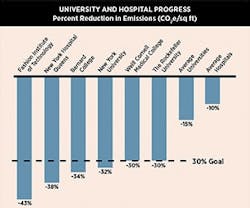Harness Carbon Challenge Successes at Your Facility
The concrete jungle is primed to get greener in the foreseeable future. PlaNYC – New York City’s sustainability initiative – aims to lower citywide greenhouse gas emissions 30% by 2030, but reaching that milestone requires partnerships between government and private sectors.
Mayor Bloomberg launched the Mayor’s Carbon Challenge to engage institutional and private sector leaders in sustainability efforts. Since its announcement in 2007, 17 leading universities, 11 hospital systems, and 10 global companies with significant office space in the city have accepted the challenge.
The challenge inspires commitment by creating a platform for the exchange of information and ideas while providing simple tools to track and measure your progress. By the end of the program, participants will have reduced emissions by 600,000 metric tons per year and saved over $100 million in reduced energy costs annually.
Let Past Progress Pave Your Way
In six years, universities have reduced emissions by 15%, while hospitals have cut them by nearly 10% in four years. Commercial offices are leading the way with a 23% slash.
At least six participants have already met the ultimate goal. Together, these early adopters have cut their emissions by about 90,000 metric tons annually and are saving nearly $20 million per year in reduced energy costs. The following success stories might work at your site.
Barnard College implemented retro-commissioning to identify initiatives and has since lowered emissions by 34% – saving an estimated $1 million per year. Among its projects are an energy efficient lighting retrofit with timers and sensors; an extensive facade, roof, and window restoration; and a web-based building management system to better monitor ongoing energy use.
The Fashion Institute of Technology (FIT) replaced an outdated chiller plant to better match cooling demand and increase operating efficiency. FIT also replaced windows with low thermal emissivity glass to reduce heat loss and painted more than 10,000 square feet of roofs with reflective paint to reduce summer cooling demand. Its Shirley Goodman Resource Center also features a green roof.
New York University (NYU) constructed a 13.8 mW cogeneration plant to provide heating, cooling, and electricity to 40 buildings. The institution also installed occupancy sensors for lighting and HVAC and expanded the use of building management systems. Having already achieved a 30% emissions reduction, NYU now intends to cut its emissions in half by 2030.
If you’re having trouble rising to the Carbon Challenge, look to these sites. Answering the call is a win-win for city and facility.
